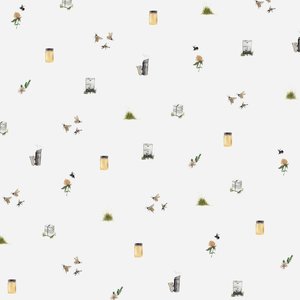WHO ARE THE POLLINATORS?
Bees are at the heart of Apiary Made, and being great pollinators, we thank them dearly for their work. But there are many other pollinators that also contribute to life as we know it. Our new Pollinator’s Garden pack, in collaboration with Australian Illustrator Min Pin, helps us tell a story about the complex world of pollination. We think it’s fitting to have a food wrap that talks about pollinators, as one out of every three bites of food depends on them! (Forbes)
Australian pollinator week is a wonderful opportunity to learn more about the process of pollination. Plus the fundamental vectors. This year, we thought we would fill your brain with all the lovely creatures featured in our Pollinator’s Garden design, and share an interesting fact about them and their role as a pollinator.
So first, what is pollination?
Pollination occurs when a pollen grain is moved from the male part of a flower to the female part. According to pollinator.org, “…it is the initial step in a process that produces seeds, fruits, and the next generation of plants.”
Pollinating animals help this occur by going from plant to plant, carrying pollen on their bodies in a variety of different ways. Pollination can also occur though self-pollination, wind and water pollination (pollinator.org).
Bees are known as very efficient pollinators, namely because they can visit lots of flowers and carry pollen on their bodies from flower to flower. Plus the way they do this is rather sophisticated. In this new print of ours, we have three types of bees:
- European Honey Bee
- Blue-banded bee
- Bumble Bee
Q. Do you know which one of the three is native to Australia?

A. The blue-banded bee is a solitary bee native to Australia. It has beautiful turquoise stripes, hence its name. The blue-banded bee is useful to our agriculture because it is one of the few bee species in Australia that performs ‘buzz pollination’. This type of pollination is great for crops like tomatoes, kiwi fruit, eggplants and more (australiangeographic.com.au).
Okay, so bees are obvious pollinators… but what about bats?!
In fact, worldwide, over “500 species of flowers in at least 67 plant families rely on bats as their major or exclusive pollinators…” (nwf.org). They have great mobility which makes them successful pollinators. You can read more about the importance of flying-foxes, native to Australia, HERE.

Also found in the sky, but active in the daytime, are birds. Birds are pollinators too. Take the rainbow lorikeet, according to CSIRO, as it feeds on nectar and pollen, the “pollen brushes against the bird’s forehead and throat and is spread to other flowers as it feeds” (CSIRO).
Lady bugs are also very useful, tiny pollinators with wings. Not only do they serve as protection for garden plants against aphids, but as they move along flowers, they move pollen too.
Now let’s look on the ground…
Here we find lizards such as skinks and geckos. These are pollinator animals. Q. Do you know what part of their body carries pollen?

A. In fact, as they feed on nectar from flowers, pollen sticks to their scales, allowing for movement of the pollen (CSIRO).
Look closer…
There’s ants! This is interesting- while ant pollinators are thought to be rather rare, and have a more complicated relationship with plants, here is a link to an article about how the native smokebush plant in WA has actually adapted and evolved for ants to pollinate it, over bees.
https://www.abc.net.au/news/2020-06-19/unique-wa-plants-adapt-to-allow-for-ant-pollination/12350088
While the plant has a special relationship with native bees, apparently introduced honeybees are too big for the flowers, meaning the honeybees would steal the nectar but not pollinate in return, meaning the plant has evolved a better relationship with ants.
Another rarer type of pollinator are snails and slugs. Sometimes, flowers are so close to the ground that they won’t attract pollinators that fly, plus, they may be covered with leaf litter. Wild ginger is commonly cited to be a plant pollinated by this group (AcademicJournals.org).
What about the plants?
We also have included the following native plants in the Pollinator’s Garden design:
– Wattle flowers
– Grass trees
– Gum leaves and gum nuts
– Native grasses
– Banksia
Q. Can you can spot them… which one is the depicted grey and black plant with the pointed tip?

A. A grass tree, drawn here as a grey and black plant with a long point. These plants are important to Aboriginal people, for various uses including the resin being used traditionally for glue in spear-making and the flower spikes as fishing spears and fire sticks (bushheritage.org).
Native plants are important to our short story on pollination because their pollination by native animals is also a significant relationship! For example, Australian native bees pollinate native plants and have over time evolved unique ways to pollinate particular flowers, such as the buzz pollination we mentioned earlier (aussiebee.com.au).
Altogether, these pictured animals and elements and more make up a ‘pollinator’s garden’. We hope you learned something new!




